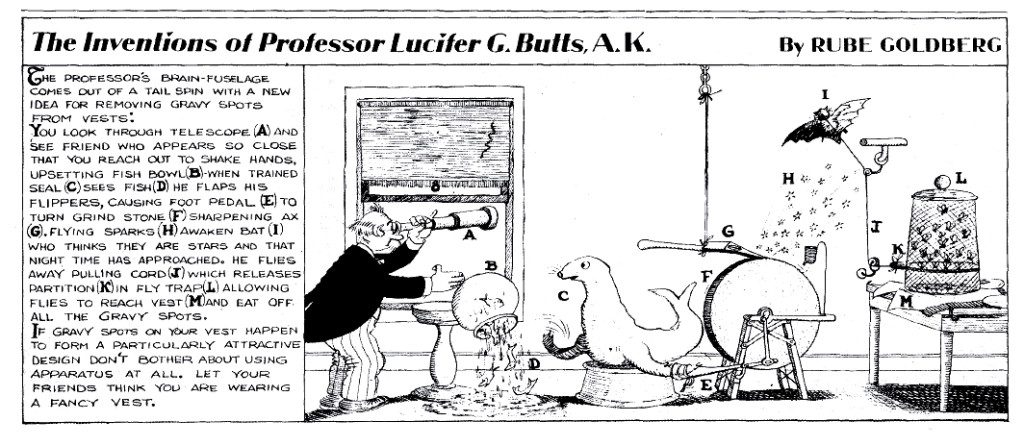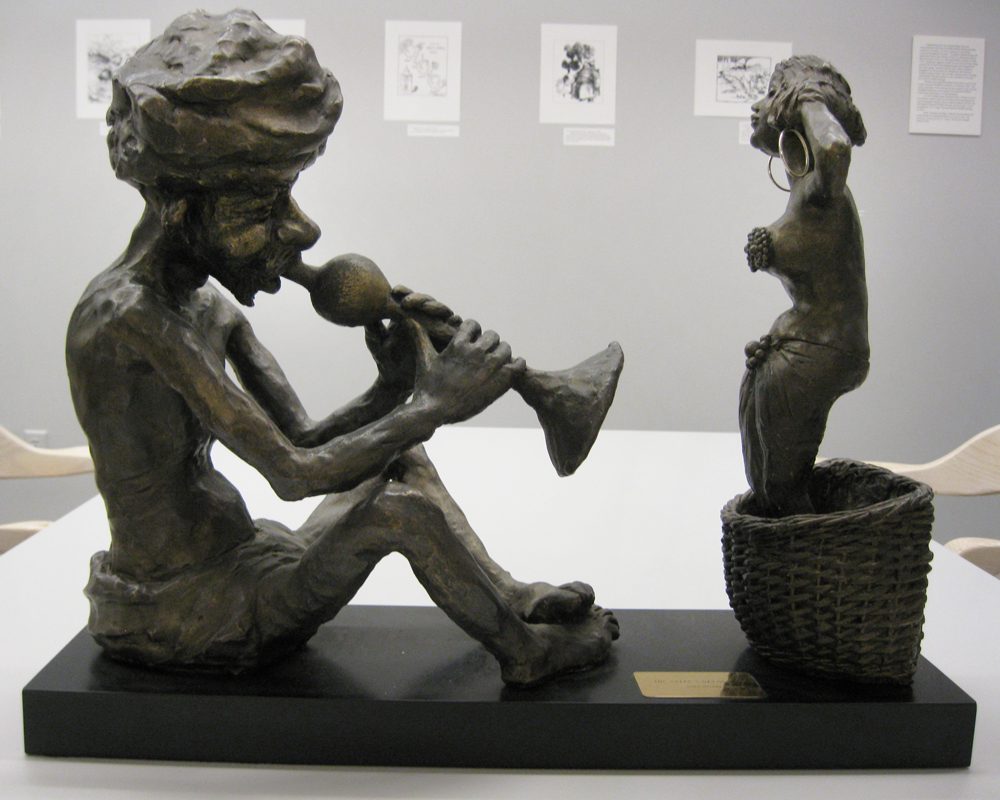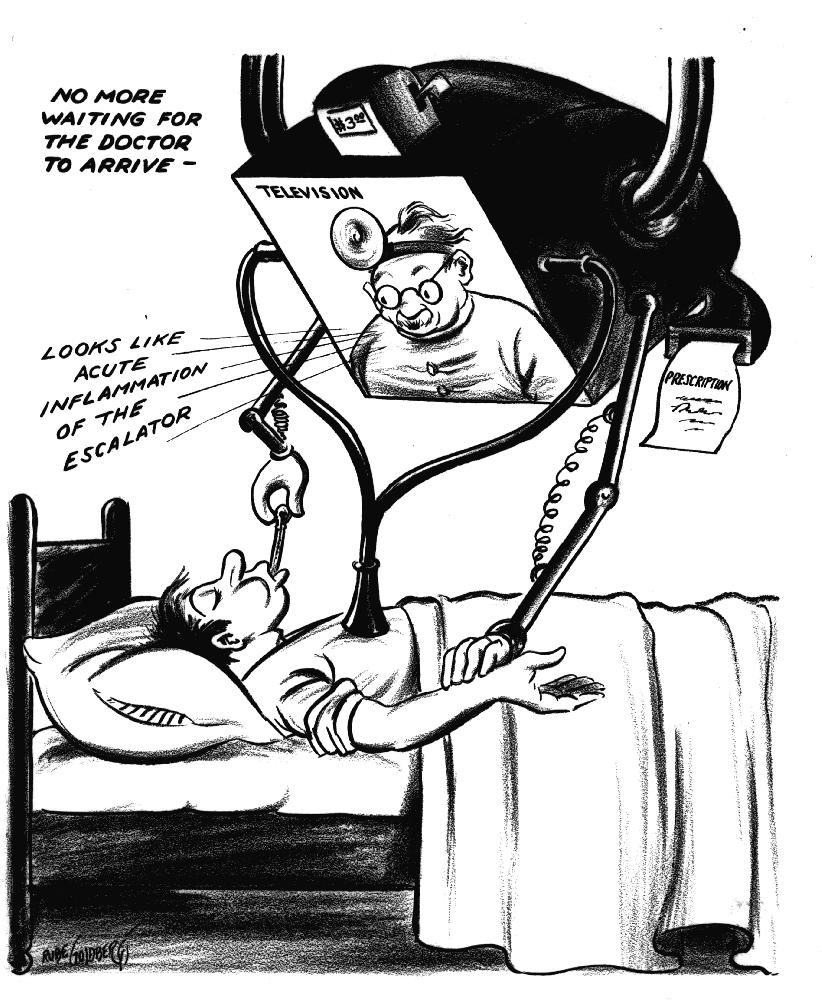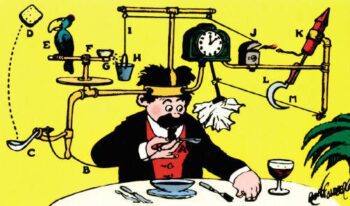
The New York Comics & Picture-Story Symposium is a weekly forum for discussing the tradition and future of text/image work. Open to the public, it meets Tuesday nights at 7-9 p.m. EST in New York City. Presentations vary weekly and include everything from historical topics and technical demonstrations to creators presenting their work. Check out upcoming meetings here.
At the 76rd meeting of the New York Comics and Picture-story Symposium. Jennifer George and Charles Kochman discussed The Art of Rube Goldberg, a book they collaborated on that was published in November of 2013. Over the course of the evening, the discussed the breadth of Goldberg’s work his importance to pop culture in general, and George peppered in tidbits about the family,.George is the granddaughter of Rube Goldberg, as well as a writer and fashion designer. Kochman is the editorial director of Abrams ComicArts.
The discussion began with the duo displaying the cover of The Art of Rube Goldberg, featuring the cartoon “A simple way to get a glass of fresh-squeezed orange juice.”
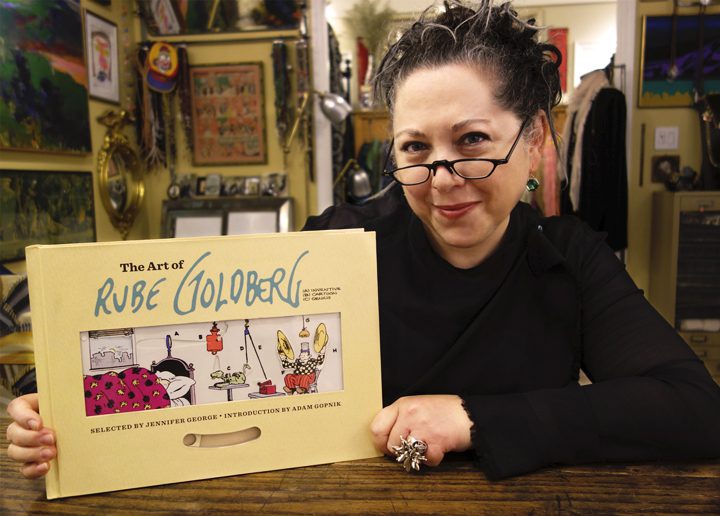
They segued into a discussion of what constitutes a Rube Goldberg machine, starting with the definition taken from the Merriam-Webster dictionary:
Rube Goldberg. : adjective \ˈrüb-ˈgōl(d)-ˌbərg\ accomplishing by complex means what seemingly could be done simply <a kind of Rube Goldberg contraption … with five hundred moving parts — L. T. Grant>; also : characterized by such complex means
George added that the definition needed refinement. She thought to qualify as a “Rube Goldberg” the devices needed to “be funny and have a narrative.” She then showed a clip from the 1937 movie “Artists and Models,” in which Jack Benny interviews has a brief conversation with Rube Goldberg.
[youtube http://www.youtube.com/watch?v=YsiUwULeZG4&w=420&h=315]
Kochman pointed out how much of celebrity Rube Goldberg during his heyday and that’s why he appeared in thing like movies. Goldberg socialized with Groucho Max, the Gerschwin, and Charlie Chaplin among others. He noted that the first Three Stooges movie, “Soup to Nuts,” was written by as Goldberg. George pointed out that she never knew him as a celebrity, but rather a bespoke man in bow ties and suspenders, and shared a few family photographs. However, both Kochman and George noted that in 1916 Goldberg made a whopping $100K between his syndicated strips and his animation work.
George considered Goldberg’s best work to be done between 1928 and 1934. She said that’s when he was at his “apex” and produced his best ideas, as well his best line work. George said that she loves Goldberg’s strip featuring what she terms as “wearables.” George noted her favorite series was “Professor Butt’s Arc,” which was from that period.Kochman described how prolific Goldberg was, producing weekly illustrations for Collier’s magazine, as well as keeping up with his daily newspaper strips. Goldberg produced over 50,000 comics over the course of his 72 year career.
George said that over the course of the book that she wanted the audience to “understand how Rube’s engineering degree influenced his art and his storytelling.” Kochman described how the new book’s pictures were shot from the original art, so that the pictured had greater clarity and detail then other books documenting Goldberg’s work. George mentioned that many of the images in the book were housed under her bed in her New York City apartment.

Then they showed rare color art, and his work in advertising. George interrupted to discuss how Goldberg’s line changed over time. She attributed it to his becoming too busy, and so he hired assistants, known as “stooges,” to help complete his art.
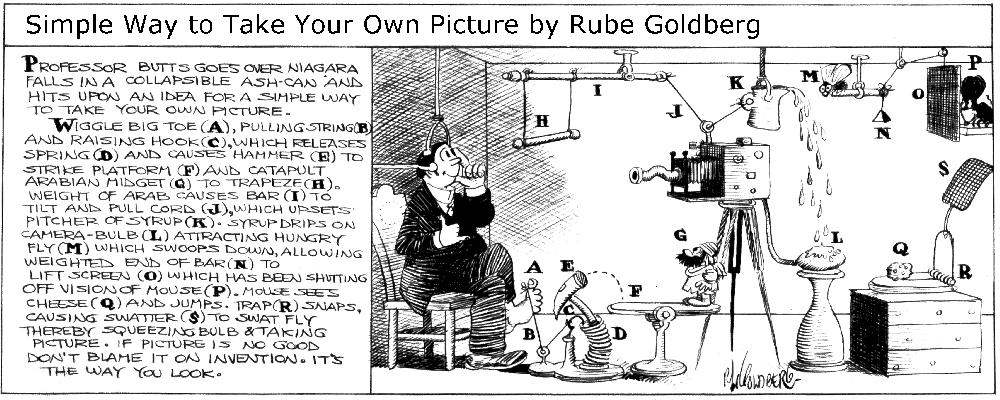
George talked briefly about Goldberg’s early, forgotten work. Her favorite was “The Weekly meetings of the Tuesdays Ladies Club.” Said that this strip was created about the time when Goldberg started to date date his future wife, Irma. George said the strips were hilarious and that it was like Girls, the HBO series, but set 100 years ago.
George said Goldberg hated animation though he created seven short animated films. The first being in 1916. Goldberg and Walt Disney mutually loathed one another, due to ego clashes. Goldberg thought Disney was a “mediocre talent with a mouse.” Kochman went on to say that during research for The Art of Rube Goldberg, an early “machine” strip was found, labeled as July 17th, 1912. This pre-dates what was original thought as the first machine strip by five years. They then showed early ephemera of Goldberg’s including his high school report card and drawings that he did for his high school yearbook.
They talked about Goldberg’s influences and characters. Collier’s Magazine’s Professor Butts was based on actual professor during his university days, Professor Slate. Slate gave his engineering class the task to build a contraption to weigh the world. Goldberg thought the idea was so ridiculous that he took with him the idea to create a Professor who created ridiculous machines.
They went onto describe how in his later years how Goldberg lost his fine motor skills and took to sculpture. George told the story of how as a little girl she snuck into his studio to look at his incomplete work. She lifted up the gauze of one of the pieces to see a startling rendition of her grandmother sculpted in black clay. However, Goldberg never cast the piece as he could never felt he could depict Irma as he saw her.
On Goldberg’s lasting impact upon culture, George noted how a number of sayings and ideas came from Goldberg, including “Mike and Ike,” “Lollapalooza,” and “No matter how thin you slice it, it’s still baloney.” She cited the game board game Mousetrap as many children’s introduction to Rube Goldberg machines. She pointed out that Rube Goldberg machines are still popular today, such as OK Go’s music video “This Too Shall Pass” as a contemporary example of Goldberg’s classic inventions.
[youtube http://www.youtube.com/watch?v=qybUFnY7Y8w&w=560&h=315]
Regarding future projects, Kochman mentioned a discussion on Rube Goldberg being hosted at the 92nd Street Y on March 10th. The discussion will feature Jennifer George in conversation with Al Jaffee and Adam Gopnick. Information can be found here George and Kochman also announced an enhanced ebook version of “The Art of Rube Goldberg” was being produced. The ebook would contain 400 of his drawings featured in the print version, as well as additional cartoons that couldn’t be included. It should be coming out in July in collaboration with Apple. Also a font in the work using Goldberg’s handwriting, and the creation of a searchable archive of Goldberg related material. There is no release date for either of these projects.
They concluded the talk by showing a short film/animation called “Something for Nothing,” that starred Rube Goldberg.
[youtube http://www.youtube.com/watch?v=KJnJ0q72STU&w=420&h=315]
Image List:
Image 1: Jennifer George with The Art of Rube Goldberg
Image 2: The Self-wiping Napkin, Rube Goldberg
Image 3: A Simple Way to Take Your Own Picture, Rube Goldberg
Image 4: Bobo Baxter Strip, Rube Goldberg
Image 5: The Inventions of Lucifer G. Butts, Rube Goldberg
Image 6: Snake’s Day Off, Rube Goldberg
Image 7: No More Waiting for the Doctor, Rube Goldberg
About the Author: Stephen Moles is a writer who lives in Brooklyn.


